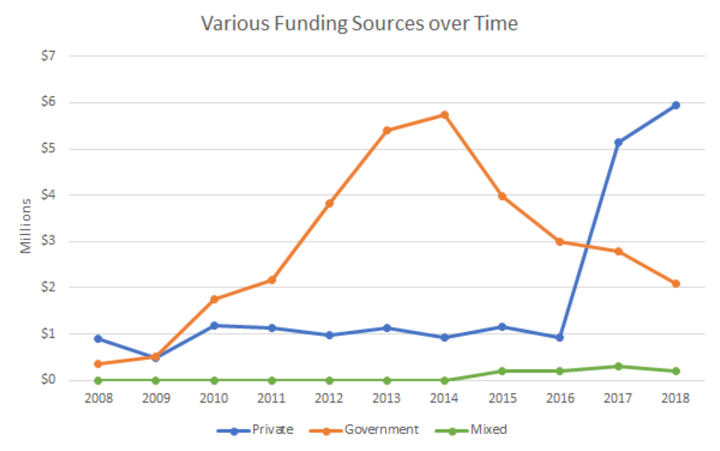
It is, quite literally, the stuff of science fiction. But on Thursday the United States inched closer to realizing what, depending on where you fall, could be considered a dream of environmental engineering or a dystopian nightmare: devising a plan to artificially cool the planet if humans fail to cut climate-changing emissions quickly enough.
In a 329-page report, the National Academies of Sciences, Engineering, and Medicine outlined its vision for a federal program to study what’s collectively known as solar geoengineering ― a handful of techniques to reflect sunlight back into space or manipulate cloud coverage to temporarily alleviate the effects of pollution-fueled heating.
The program would be a giant leap forward for a concept first popularized in 2006 by Nobel laureate Paul Crutzen, a Dutch atmospheric chemist who advocated releasing particles roughly 31 miles up in order to dim the sky and provide an “escape route” from runaway climate change. Though fringe and widely feared at the time, the idea of solar geoengineering has gained traction as warming projections worsen and the window to dramatically slash emissions and avert catastrophe closes.
Just broaching the subject stirs controversy. Providing governments with a global thermostat risks disincentivizing the hard work of phasing out fossil fuels and industrial meat farming. There’s conflicting research on whether the most common proposal to geoengineer the planet ― spraying reflective sulfur aerosols into the stratosphere ― might inflict worse droughts and storms in different hemispheres, potentially exacerbating inequities between rich northern countries and poorer nations south of the equator. Then there are fears of how climate controls could be weaponized for war.
Yet emissions keep climbing ― with the exception of 2020, when pandemic-induced lockdowns temporarily halted factories and took millions of gas-burning cars off the road ― and private financiers are pouring money into solar geoengineering research anyway.
The National Academies plan, if implemented, would at least double the total research funding for solar geoengineering to date, and would represent the largest government-led effort anywhere in the world.
The proposal calls for a federal research program initially funded with $100 million to $200 million over five years, earmarking roughly 20% for public outreach and ethical governance. The project would exist under the U.S. Global Change Research Program, a White House-led effort combining expertise and funding from 13 federal agencies. It contains various proposals for bureaucratic oversight that would dictate “exit ramps” to halt research if the findings or the effect of the studies on public attitudes became too risky.
“The U.S. solar geoengineering research program should be all about helping society make more informed decisions,” Chris Field, director of the Stanford Woods Institute for the Environment and chair of the committee that wrote the report, said in a statement. “This research program could either indicate that solar geoengineering should not be considered further, or conclude that it warrants additional effort.”
The report explicitly states that this program “should be a minor part of overall U.S. research” on climate change, and “should focus on developing policy-relevant knowledge, rather than advancing a path for deployment.”
“It is very well thought out, without any preconceived notions, and a very timely and prudent approach,” Youba Sokona, a climate scientist from Mali and the vice chair of the United Nations’ Intergovernmental Panel on Climate Change, said of the report, while noting that he was not speaking on behalf of the IPCC. “The critical unknown issues have been identified, and more importantly, emphasis has been put on the crucial need for mitigation and adaptation at the same time.”
But skeptics who question the wisdom of even studying geoengineering say the proposal takes broad leaps beyond what the National Academies first outlined in its initial report in 2015, and that it endangers hope of crafting international agreements to guard against rogue deployments by sketching out a national program. Some argued that simply carrying out the research has jeopardized long-overdue efforts to eliminate climate-changing emissions in the first place ― efforts that are finally taking shape in the United States, Europe and China.
“Spending this money dangles this possibility that there’s this technology out there that might save us, so it diminishes the value of doing the real systemic changes that are needed to address the climate crisis,” said Jennie Stephens, the director of Northeastern University’s School of Public Policy and Urban Affairs. “I don’t think the federal government should be doing this research.”

An Excuse To Keep Burning Fossil Fuels, And Unknown Risks
Advocates and social scientists have long argued that anything that hedges against decarbonization, the process of rapidly weaning the world off fossil fuels and other sources of planet-heating pollution, dims the chances of making it happen. The argument has a point. Humans have understood the effects of burning coal, oil and gas for more than a century. Congress held the first hearings on what was then called the “greenhouse effect” in the 1980s.
A sophisticated campaign by the oil and gas industry to seed skepticism about the realities of climate science ― led by the same public relations experts whom tobacco companies employed to delay regulations on cigarette smoking ― successfully prevented any climate action for decades. Emissions of carbon dioxide and methane have grown steadily year after year.
Yet even as climate denial has faded, demand has grown for policies that go beyond simply slashing emissions. For years, many of the same advocates who now oppose geoengineering out of concern for the moral hazard it poses to decarbonization inveighed similarly against adapting to climate change with infrastructure like sea walls and policies to move communities from low-lying areas. After years of delay, the Global Commission on Adaptation, a nongovernmental organization led by former U.N. Secretary-General Ban Ki-Moon, last year called for investing upward of $1.7 trillion in adaptation programs.
The National Academies report seeks to allay these concerns. An entire section of the introduction is titled “Solar Engineering Is Not a Substitute for Mitigation.” Deeper in the report, the authors recommended requiring that funding for a solar geoengineering research program only increase in tandem with budgets for mitigation, to prevent “those with vested interests in fossil fuels” from seizing “on the prospect of geoengineering as a ‘solution’ to climate change to support their interests.”
“It seems to hit all the important points and has an appropriately cautious tone,” said Peter Irvine, a geoengineering researcher and earth science lecturer at University College London who was not involved in the paper. “That they are not recommending that this be developed but only that it be assessed at this time, I think, is quite wise.”

What The Science Says About The Known Risks
Visions of a geoengineered future imagine fleets of planes, deployed either by governments or wealthy tycoons, spraying sulfur aerosols into the atmosphere on continuous flight paths, mimicking the cooling effect that massive volcanic eruptions have had on the planet in the past. Research suggests the sky would turn from blue to white. There would likely be some spectacular sunsets.
But the details, as parsed so far by existing research, offer plenty of room for the devil to hide.
A 2013 study in the journal Nature Climate Change found that spraying aerosols in the Northern Hemisphere, such as over the United States or Japan, would likely reduce rainfall in areas closer to the equator, including the drought-parched Sahel, the semi-arid African region that includes Algeria, Mali and Sudan. A 2017 study in the journal Nature Communications determined that solar geoengineering in the north would shift the position of the tropical jet stream south, and vice versa, potentially unleashing powerful cyclones and hurricanes on whichever region misses out.
A 2019 study in JGR Atmospheres showed that solar geoengineering risks disrupting rainfall in South Asia and much of Africa, which would threaten the only irrigation system on which billions of poor farmers rely. A 2020 paper in Geophysical Research Letters backed up the idea that geoengineering in any form would throw jet streams out of whack, possibly adding novel changes to the climate in tropic regions where half the world’s population lives.
“The risks of climate change are already borne by the very same people who would bear the risks of solar geoengineering,” said Prakash Kashwan, a political scientist at the University of Connecticut. “So this risk-risk framework, the notion that there’s climate risk that will be offset by geoengineering, has a very different color depending on who’s talking about it and who you have in mind when you say ‘risk-risk.’”
Other research, though, paints a far more hopeful picture. A 2018 paper in the journal Earth’s Future debunked one of the longstanding concerns over solar geoengineering, that suddenly halting the process would result in a chaotic, rapid warming known as “termination shock.” A 2019 study in Nature Climate Change outlined a geoengineering scenario in which it would be possible to dim the sky in such a way that no region of the world would face worse changes to temperatures, precipitation or drought than it would under normal warming scenarios.
The other two areas of research outlined in the National Academies paper propose injecting aerosols into marine clouds to brighten them, and pumping dust into wavy, hairline cirrus clouds to thin them. Both subjects have undergone significantly less study.
Banking On International Cooperation
The potential regional disparities in how geoengineering could be felt served as a central plot point in sci-fi writer Kim Stanley Robinson’s latest blockbuster novel, “The Ministry for the Future.” The book, published in October, depicts a catastrophic heat wave in India that kills 20 million people in two weeks, prompting the government in New Delhi to go ahead and start geoengineering the stratosphere on its own.
The National Academies report outlines possible international governance regimes to avoid one country going rogue and unleashing harsh climatic consequences on other nations.
It suggests expanding on the U.N. Conventions on Biodiversity, under which, in 2010, the world declared a loose moratorium on climate “technofixes” that could harm wildlife. Other conventions on cross-border ozone pollution, or the baseline climate agreements on carbon dioxide themselves, could offer similar models for regulating geoengineering.
Another promising area, the report argues, is the U.N.’s 1977 Convention on the Prohibition of Military or Any Other Hostile Use of Environmental Modification Techniques, a rule barring countries from manipulating weather for war that came of revelations that the U.S. tried to weaponize clouds during the Vietnam War. So far, however, efforts to update those agreements to account for geoengineering have fallen flat. The most recent effort to provide guidelines for geoengineering in 2018 failed after the United States and Saudi Arabia voted it down.
That makes the proposal, according to Mount Holyoke College environmental studies researcher Kevin Surprise, a “U.S.-first effort.”
“Given the way world politics are structured and ongoing geopolitical tensions, it’s a really risky gamble for the U.S. to say we’re pushing forward with this, we’re heavily invested, and we’re doing this without international consultation,” he said.

Charging ahead with research before those international structures are in place would present significant dangers, said Aarti Gupta, a professor of global environmental governance at Wageningen University in the Netherlands.
“We need international political deliberation of whether to even launch exploratory research programs,” she said. “And this is not pie-in-the-sky and to be dismissed, but really where the challenge lies. We cannot put off international, multilateral political control over these early stages of research and deliberation.”
The Risk Of Leaving That In Private Hands
Absent an international agreement, policies overseeing geoengineering could become Balkanized. But another risk could be that the research remains in the control of the unaccountable private actors who are currently backing most research.
Private funding kicked off some of the first major experiments examining the potential to geoengineer lower temperatures in 2008. A year later, governments started stepping up. European countries ― namely the United Kingdom, Germany and Norway ― led the way, providing nearly $20.4 million between 2008 and 2018. North American governments, mainly the U.S., kicked in another $7.2 million in that time, and Asian nations, primarily China, gave just under $4 million.
Private backers in North America alone nearly matched all of Europe, investing some $18.1 million into research. By 2017, private capital had eclipsed government support, buoyed by high-profile underwriters like Microsoft billionaire Bill Gates and venture capitalist Chris Sacca.
Congress tilted the scales slightly back in the other direction in December 2019, when it granted the National Oceanic and Atmospheric Administration $4 million to research “solar climate interventions,” including “proposals to inject material [into the stratosphere] to affect climate.”
But as it is, the National Academies study itself was sponsored in part by the BAND Foundation, the Christopher Reynolds Foundation, the MacArthur Foundation and the V. Kann Rasmussen Foundation.
While a federal program with a budget of up to $200 million would vastly expand that funding, it would be by no means tremendous. It would amount to at most $40 million per year over five years, with roughly $8 million of that committed to public outreach and bureaucratic processes to ensure that the research stays within the ethical guidelines set out by the National Academies. Much of the actual research budgets, moreover, would go to pay grad students and postdoctoral fellows to conduct climate research and boost funding for the institutions where they carry out those studies.
The status quo offers no such public assurances or benefits.
“The counterfactual scenario is you have these random philanthropists and VC funds viewing solar geoengineering as part of ‘climate tech’ generally,” said Holly Jean Buck, an assistant professor at the University of Buffalo who published a book on geoengineering in 2018. “It might sound scary to have $100 or $200 million of research by the U.S. government. But I think it’s way better than the alternative scenario.”

